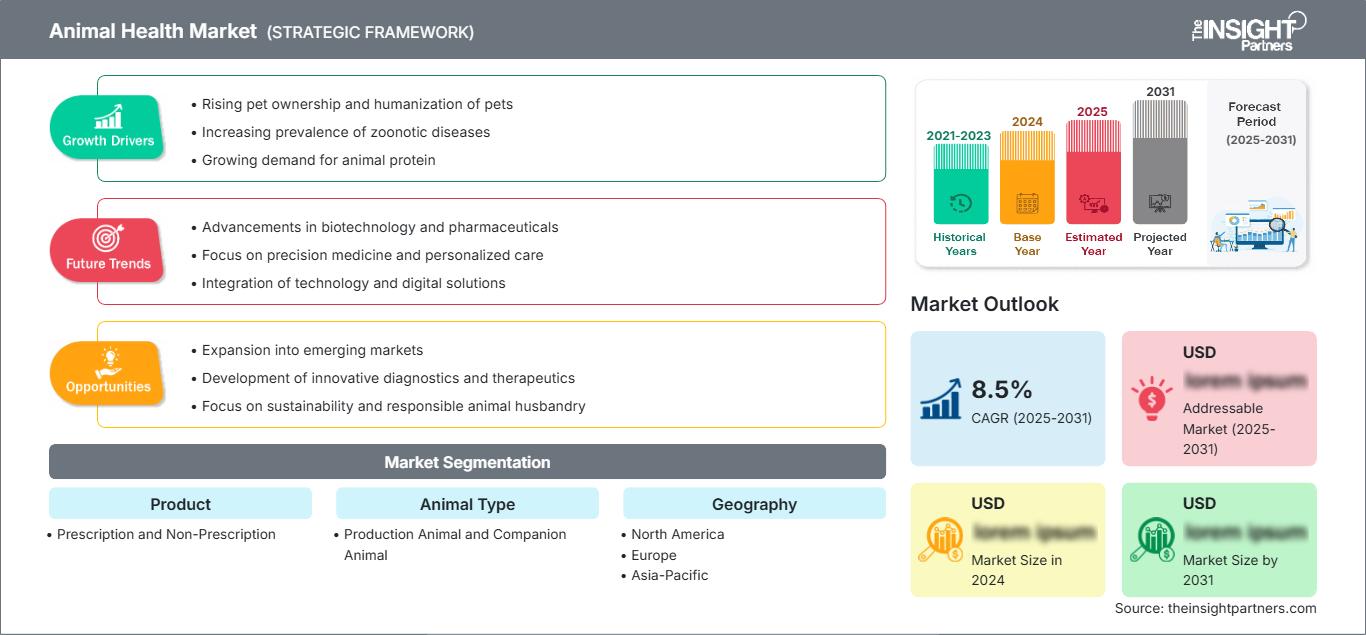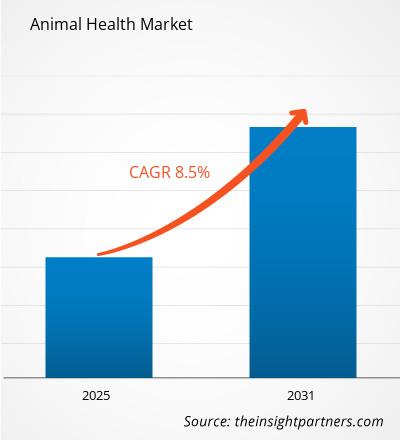Se espera que el tamaño del mercado de salud animal alcance los US$ 144,15 mil millones para 2031. Se anticipa que el mercado registre una CAGR del 6,8% durante 2025-2031.
El informe se divide en dos secciones: Producto (con y sin receta) y Tipo de animal (animal de producción y de compañía). El análisis global se desglosa por región y por países principales. La evaluación del mercado se presenta en dólares estadounidenses para el análisis segmentario mencionado.
Propósito del Informe
El informe "Mercado de Salud Animal" de The Insight Partners busca describir el panorama actual y el crecimiento futuro, los principales factores impulsores, los desafíos y las oportunidades. Esto proporcionará información a diversas partes interesadas del negocio, como:
- Proveedores/fabricantes de tecnología: Para comprender la dinámica cambiante del mercado y conocer las oportunidades potenciales de crecimiento, lo que les permitirá tomar decisiones estratégicas informadas.
- Inversores: Realizar un análisis exhaustivo de tendencias respecto a la tasa de crecimiento del mercado, las proyecciones financieras del mercado y las oportunidades que existen en toda la cadena de valor.
- Órganos reguladores: Regular las políticas y las actividades policiales en el mercado con el objetivo de minimizar el abuso, preservar la confianza de los inversores y defender la integridad y estabilidad del mercado.
Segmentación del mercado de salud animal Producto
- Con y sin receta
Tipo de animal
- Animal de producción y animal de compañía
Obtendrá personalización en cualquier informe, sin cargo, incluidas partes de este informe o análisis a nivel de país, paquete de datos de Excel, así como también grandes ofertas y descuentos para empresas emergentes y universidades.
Mercado de salud animal: perspectivas estratégicas

- Obtenga las principales tendencias clave del mercado de este informe.Esta muestra GRATUITA incluirá análisis de datos, desde tendencias del mercado hasta estimaciones y pronósticos.
Factores que impulsan el crecimiento del mercado de la salud animal
- Aumento de la tenencia de mascotas y humanización de las mismas: cada vez más personas adoptan mascotas, las tratan como miembros de la familia e invierten en su atención médica.
- Aumento de la prevalencia de enfermedades zoonóticas: las enfermedades que pueden propagarse entre animales y humanos están en aumento, lo que incrementa la necesidad de medidas de sanidad animal.
- Creciente demanda de proteína animal: la población mundial está aumentando, lo que genera una mayor demanda de carne y productos lácteos, lo que impulsa la necesidad de un ganado sano.
Tendencias futuras del mercado de la salud animal
- Avances en biotecnología y productos farmacéuticos: las nuevas tecnologías están dando lugar a vacunas, diagnósticos y tratamientos más eficaces para las enfermedades animales.
- Centrarse en la medicina de precisión y la atención personalizada: adaptar los tratamientos a cada animal en función de sus necesidades específicas y su composición genética.
- Integración de tecnología y soluciones digitales: uso de la tecnología para cosas como monitoreo remoto, telemedicina y análisis de datos para mejorar el cuidado de los animales.
Oportunidades de mercado en salud animal
- Expansión hacia mercados emergentes: Muchos países en desarrollo tienen poblaciones animales en crecimiento y una demanda creciente de productos y servicios de salud animal.
- Desarrollo de diagnósticos y terapias innovadoras: creación de herramientas nuevas y mejoradas para diagnosticar y tratar enfermedades animales.
- Centrarse en la sostenibilidad y la ganadería responsable: promover el bienestar animal, reducir el impacto ambiental de la ganadería y garantizar el uso responsable de antibióticos.
Perspectivas regionales del mercado de salud animal
Los analistas de The Insight Partners han explicado detalladamente las tendencias regionales y los factores que influyen en el mercado de salud animal durante el período de pronóstico. Esta sección también analiza los segmentos y la geografía del mercado de salud animal en América del Norte, Europa, Asia Pacífico, Oriente Medio y África, y América del Sur y Central.
Alcance del informe del mercado de salud animal
| Atributo del informe | Detalles |
|---|---|
| Tamaño del mercado en 2024 | XX mil millones de dólares estadounidenses |
| Tamaño del mercado en 2031 | 144.150 millones de dólares estadounidenses |
| CAGR global (2025-2031) | 6,8% |
| Datos históricos | 2021-2023 |
| Período de pronóstico | 2025-2031 |
| Segmentos cubiertos | Por producto
|
| Regiones y países cubiertos | América del norte
|
| Líderes del mercado y perfiles de empresas clave |
|
Densidad de actores del mercado de salud animal: comprensión de su impacto en la dinámica empresarial
El mercado de la salud animal está creciendo rápidamente, impulsado por la creciente demanda del usuario final debido a factores como la evolución de las preferencias de los consumidores, los avances tecnológicos y un mayor conocimiento de los beneficios del producto. A medida que aumenta la demanda, las empresas amplían su oferta, innovan para satisfacer las necesidades de los consumidores y aprovechan las tendencias emergentes, lo que impulsa aún más el crecimiento del mercado.

- Obtenga una descripción general de los principales actores clave del mercado de salud animal
Puntos clave de venta
- Cobertura integral: el informe cubre de manera integral el análisis de productos, servicios, tipos y usuarios finales del mercado de salud animal, proporcionando un panorama holístico.
- Análisis de expertos: el informe se compila con base en el conocimiento profundo de expertos y analistas de la industria.
- Información actualizada: El informe asegura relevancia comercial debido a su cobertura de información reciente y tendencias de datos.
- Opciones de personalización: este informe se puede personalizar para satisfacer los requisitos específicos del cliente y adaptarse adecuadamente a las estrategias comerciales.
Por lo tanto, el informe de investigación sobre el mercado de la salud animal puede ayudar a descifrar y comprender el panorama del sector y sus perspectivas de crecimiento. Si bien existen algunas preocupaciones válidas, las ventajas generales de este informe suelen superar las desventajas.
- Análisis histórico (2 años), año base, pronóstico (7 años) con CAGR
- Análisis PEST y FODA
- Tamaño del mercado, valor/volumen: global, regional y nacional
- Industria y panorama competitivo
- Conjunto de datos de Excel
Informes recientes
Informes relacionados
Testimonios
Razón para comprar
- Toma de decisiones informada
- Comprensión de la dinámica del mercado
- Análisis competitivo
- Información sobre clientes
- Pronósticos del mercado
- Mitigación de riesgos
- Planificación estratégica
- Justificación de la inversión
- Identificación de mercados emergentes
- Mejora de las estrategias de marketing
- Impulso de la eficiencia operativa
- Alineación con las tendencias regulatorias




















 Obtenga una muestra gratuita para - Mercado de salud animal
Obtenga una muestra gratuita para - Mercado de salud animal